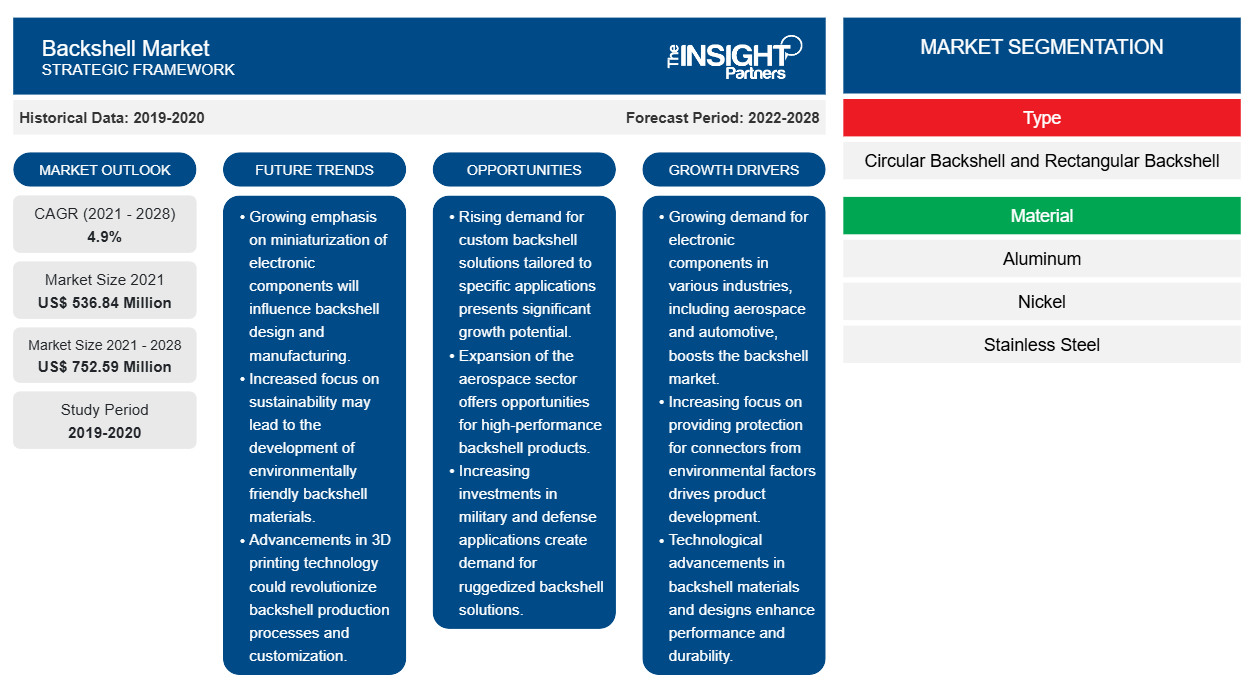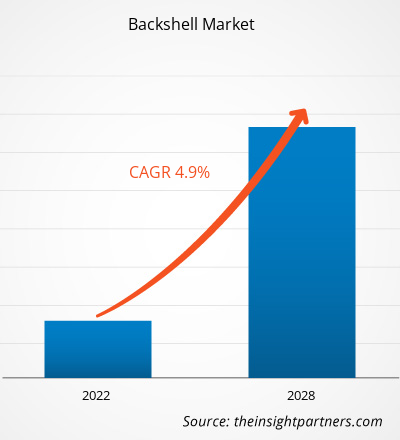The backshell market was valued at US$ 536.84 million in 2021 and is projected to reach US$ 752.59 million by 2028; it is expected to grow at a CAGR of 4.9% from 2021 to 2028.
The automotive industry is undergoing a shift from internal combustion engines to electrification owing to the increasing concerns regarding carbon emission. The vehicles used armed forces are major diesel-powered and it lacks the quick maneuverability capabilities of an electric-powered vehicle, such as increased torque, towing capability, and climbing ability. Moreover, the thermal signature of an Electric Vehicle (EV) cannot be detected from a long distance that of an internal combustion engine, which acts as a major benefit on the battlefield. Currently, the US Army is actively evaluating various options with automotive manufacturers to develop electric vehicles for military applications. For instance, in 2020, the Maneuver Capabilities Development and Integration Directorate (MCDID) approved the study of tactical and combat vehicles with electric engines. Moreover, in May 2021, General Motors demonstrated an EV prototype of its Infantry Squad Vehicle (ISV) for military application. Additionally, the US government awarded contracts to companies to study various techniques for powering a future fleet of 225,000 electric military vehicles. Thus, the development of EVs for military applications would propel the adoption of military-grade connectors, which would subsequently drive the growth of the backshell market in the future.
Impact of COVID-19 Pandemic on Backshell Market
The outbreak of the COVID–19 has significantly affected the world and is continuing to shatter several countries. Until the outbreak, the aerospace & defense industry was experiencing substantial growth in terms of production, despite huge backlogs from the aircraft manufacturers. The global aviation industry witnessed a significant rise in the number of passengers count and increase in aircraft procurement.
Unfortunately, the COVID–19 outbreak has decimated the demand for aircraft across the world. Owing to the crisis, aircraft manufacturers witnessed the reduction in the volumes of orders, which resulted in a lower number of productions. The decline in production volumes adversely affected the businesses of various component manufacturers and associated technologies. Thus, the backshell market players' businesses have been severely affected by the destabilization in aircraft production. Amid COVID-19 outbreak, the aerospace & defense industry witnessed tremor with minimal resources to foresee the future. Several production units in the US, France, Russia, and China were temporarily closed in order to adhere to the government rules regarding lockdown and physical distancing. The aircraft manufacturers witnessed 30–50% reduction in demand for most of the aircraft models, especially, commercial aircraft models. The restrictions on the production and assembly of aircraft and military ground vehicles have hindered the demand for backshell, resulting in lower revenue generation. This factor negatively impacted the backshell market.
Customize This Report To Suit Your Requirement
You will get customization on any report - free of charge - including parts of this report, or country-level analysis, Excel Data pack, as well as avail great offers and discounts for start-ups & universities
Backshell Market: Strategic Insights

-
Get Top Key Market Trends of this report.This FREE sample will include data analysis, ranging from market trends to estimates and forecasts.
Backshell Market Insights
Growing Use of Aluminum Backshell
The aluminum backshells are gaining importance in the commercial aviation business, as the commercial (civil and general aviation) aircraft manufacturers are consistently striving hard to reduce fuel consumption and CO2 emission and increase endurance. The usage of heavier metallic components restricts the aircraft OEMs to attain the above-mentioned parameters. Owing to this, the usage of lightweight components or parts is surging among these manufacturers. As the commercial aircraft OEMs are emphasizing aluminum backshells for varied connectors, the demand for aluminum backshells is growing among the MRO service providers. Apart from the owners of the newly manufactured aircraft fleet, the owners of the existing aircraft fleet are also concentrating on retrofitting their aircraft models with lightweight and advanced aluminum backshells as these products increase the lifespan of connectors by 4% to 8%. Also, the retrofitting of aluminum backshell helps in reducing aircraft weight, thereby facilitating the aircraft fleet owners to accomplish their weight and CO2 reduction and longer endurance strategies. Due to this, the MRO service providers are increasingly procuring aluminum backshells, which is fueling the growth of the backshell market.
Type-Based Market Insights
Based on type, the backshell market is bifurcated into circular and rectangular. In 2020, the circular segment led the market and accounted for a larger share.
Material-Based Market Insights
Based on material, the backshell market is segmented into aluminum, nickel, stainless steel, and others. In 2020, the stainless steel segment led the market and accounted for the largest market share.
Military Standards-Based Market Insights
Based on military standards, the backshell market is segmented into AS85049 Series, MIL-DTL-38999, MIL-DTL-83723, MIL-DTL-5015, MIL-DTL-26482, and Others. In 2020, the AS85049 Series segment led the market and accounted for the largest market share.
Application-Based Market Insights
Based on application, the backshell market is segmented into ground, naval, and air. In 2020, the ground segment led the market and accounted for the largest market share.
The players operating in the backshell market adopt strategies such as mergers, acquisitions, and market initiatives to maintain their positions in the market. A few developments by key players are listed below:
- In May 2021, the DuraMateTM AHDM line of environmentally sealed, multi-pin, and heavy-duty metal circular connectors offers a cost-effective quick-connect bayonet locking system designed to handle the rigors and complexities of tough off-road applications.
- In January 2020, Glenair Swing-Arm Flex Composite 3-in-1 Backshells provided EMI/RFI cable shielding termination in electrical wire interconnect cabling that is lightweight and corrosion-free. The typical shield termination device for weight reduction in military and commercial aircraft applications is Glenair Swing-Arm Flex Composite 3-in-1 Backshells.
The regional trends and factors influencing the Backshell Market throughout the forecast period have been thoroughly explained by the analysts at The Insight Partners. This section also discusses Backshell Market segments and geography across North America, Europe, Asia Pacific, Middle East and Africa, and South and Central America.
Backshell Market Report Scope
| Report Attribute | Details |
|---|---|
| Market size in 2021 | US$ 536.84 Million |
| Market Size by 2028 | US$ 752.59 Million |
| Global CAGR (2021 - 2028) | 4.9% |
| Historical Data | 2019-2020 |
| Forecast period | 2022-2028 |
| Segments Covered |
By Type
|
| Regions and Countries Covered |
North America
|
| Market leaders and key company profiles |
|
Backshell Market Players Density: Understanding Its Impact on Business Dynamics
The Backshell Market is growing rapidly, driven by increasing end-user demand due to factors such as evolving consumer preferences, technological advancements, and greater awareness of the product's benefits. As demand rises, businesses are expanding their offerings, innovating to meet consumer needs, and capitalizing on emerging trends, which further fuels market growth.

- Get the Backshell Market top key players overview
The global backshell market has been segmented as mentioned below:
By Type
- Circular Backshell
- Rectangular Backshell
By Material
- Aluminum
- Nickel
- Stainless Steel
- Others
By Military Standards
- AS85049,
- MIL-DTL-38999,
- MIL-DTL-83723,
- MIL-DTL-5015,
- MIL-DTL-26482, and Others
- Others
By Application
- Ground
- Air
- Naval
By Geography
-
North America
- US
- Canada
- Mexico
-
Europe
- France
- Germany
- Italy
- UK
- Russia
- Rest of Europe
-
Asia Pacific (APAC)
- China
- India
- South Korea
- Japan
- Australia
- Rest of APAC
-
Middle East & Africa (MEA)
- South Africa
- Saudi Arabia
- UAE
- Rest of MEA
-
South America (SAM)
- Brazil
- Rest of SAM
Company Profiles
- Amphenol Corporation
- Arrow Electronics, Inc
- Collins Aerospace
- Curtiss Wright Corporation
- Glenair, Inc
- Isodyne Inc
- Pei-Genesis
- Souriau Sunbank (Eaton)
- TE Connectivity
- Techniran Ltd
Frequently Asked Questions
Which region has the largest market share in the backshell market?
Who are the major vendors in the backshell market?
What are the future trend for backshell market?
Which type-based segment has the largest market share in 2020?
What are the driving factors responsible for the growth of backshell market?
Increasing Military Expenditures
What are the market opportunities for backshell market?
- Historical Analysis (2 Years), Base Year, Forecast (7 Years) with CAGR
- PEST and SWOT Analysis
- Market Size Value / Volume - Global, Regional, Country
- Industry and Competitive Landscape
- Excel Dataset
Recent Reports
Testimonials
Reason to Buy
- Informed Decision-Making
- Understanding Market Dynamics
- Competitive Analysis
- Identifying Emerging Markets
- Customer Insights
- Market Forecasts
- Risk Mitigation
- Boosting Operational Efficiency
- Strategic Planning
- Investment Justification
- Tracking Industry Innovations
- Aligning with Regulatory Trends





















 Get Free Sample For
Get Free Sample For